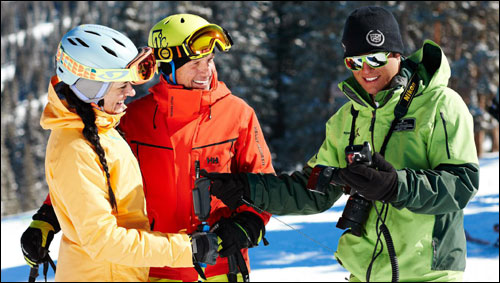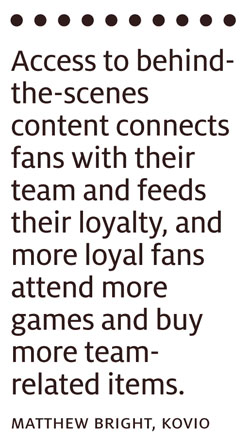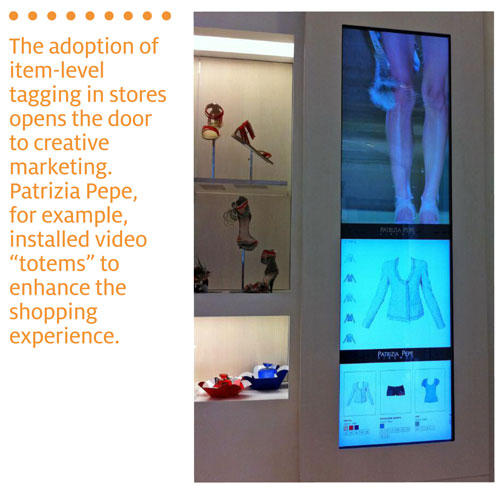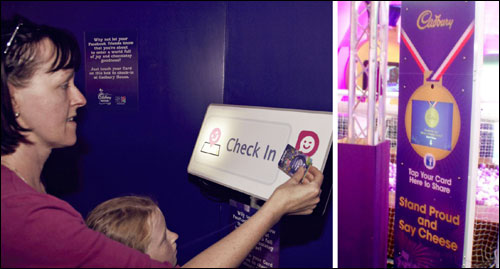Oct 27, 2014The annual, three-day C2MTL (Commerce + Creativity in Montreal) event takes pride in its novel approach to helping business leaders solve problems. At this year's conference, in May, the organizers also implemented an innovative RFID solution from Connect&Go to improve attendees' experience. The solution discreetly monitored access to the event and fostered engagement among guests. It also tracked where attendees were congregating within the 100,000-square-foot Arsenal complex, to ensure there were enough food and beverage servers.

The roughly 4,000 attendees, mostly C-level executives, were issued identification badges embedded with an ultrahigh-frequency tag. Fixed RFID gates set up at the complex's entrance, conference rooms and main forum rooms facilitated a fully contactless and seamless flow. C2MTL wanted attendees to feel welcome and not have security agents looming over them to check their badges to verify access. "Security was not necessarily an issue, but that said, because of the high value of the tickets, we wanted to make sure the right people were getting in at the proper access they paid for," says Martin Enault, VP, partnerships and technology at C2MTL, who notes a ticket cost $3,600 for a three-day package.
A main focus was reducing queues for sessions, Enault adds. The portals were positioned so only the agents could see lights indicating an invalid badge; they could then approach the individual discreetly, says Anthony Palermo, co-founder of Connect&Go and director and co-founder of RFID Academia.
RFID antennas were installed in the chandeliers in networking lounges, where there wasn't enough traffic en masse to justify setting up portals. The antennas detected who was in the area and transmitted their names and titles to a smartphone application, so attedees could know instantly of others' arrivals.
They had to sign up to be tracked like this, Enault notes. It was not done without their knowledge. "The business case for us was fairly simple," Enault says. "Using RFID enabled us to facilitate people meeting each other, and C2MTL is about connecting people and business together. It made networking easier. For us, that is ROI because the more deals being made here leads to more people wanting to come here and more partners for the event."
The information gained from having better insight into attendee flow at this year's event also will help C2MTL organizers plan for 2015, Enault says. Not all guests, for example, attended every conference session; some watched on screens outside conference rooms or were otherwise engaged. For all but a few key speeches, there were more seats than attendees in the rooms. "So we know we can sell more tickets next year without risking people not getting a seat in the conference rooms," Enault says. "The additional tickets we can sell for next year alone can pay for the entire RFID system."
In addition, the Connect&Go RFID system gave C2MTL the raw data—including time stamps to know how long individuals spent in various sessions and zones—to leverage in other ways. It can see, for instance, which sessions drew which types of attendees in terms of business function, or which topics got more traction, to help craft its next schedule to increase appeal to those demographics and interests. C2MTL also is working with a partner to slice and dice the information it gained from the RFID deployment with other data feeds, to understand things such as whether weather conditions during the event affected attendance at some points. "We want to use analytics to offer the best experience to our attendees, based on data accumulated at past events," Enault says.
RFID technology has been a presence at concerts, sports events and other consumer venues for several years, helping marketers engage with audiences, shoppers and vacationers (see The New "It" Tool for Branding Products and Services). RFID Academia developed the Connect&Go UHF Access & Monitoring System as an RFID keychain or bracelet for access control and marketing activation at consumer events. Deploying RFID technology in the business-to-business conference sector is still in the early stages, says Keith McKenna, VP of convention operations at Wyndham Jade, which provides convention housing and show registration services. Before RFID becomes commonplace at B2B events, conference organizers as well as exhibitors need to better understand how they can benefit from RFID-generated data. That, in turn, could override any concerns about deployment costs.
It's All About the Data
B2B event organizers that have employed RFID for attendee tracking value the data RFID can deliver to them about event flow, says Dale Bookout, owner of Global Registration Solutions, which provides show-management services. "When you're talking about tracking big areas like expo halls with 17,000 people going in and out, the organizers want to get a feel for what are the peak times or if they had dead times," he says. That data can inform future plans, such as having an icebreaker event on the floor during down periods to drive traffic.
Some event organizers offer RFID-enabled kiosks, where attendees can scan their badges and post comments on social-media sites. There are also opportunities to leverage information collected from RFID technology for feedback, in conjunction with surveys typically given to attendees, says Lance Burnett, CEO and founder of systems integrator Stark RFID. "Assuming you are delivering the right content, then you look at who went where and did what at the show, and how they felt about it, and you can determine from there if they were heavily engaged and interested," he says. At trade shows, this information could be shared with exhibitors to help them better target their follow-up activities.
In fact, conference organizers can use RFID as a marketing tool to potential exhibitors, offering either to share the data they collect or to install readers at their booths. "You want to know that [the event] is worth it," Burnett says, "and the only way to really know that is to have true data about who's coming by and what they're doing."
In December 2013, Global Registration Solutions worked with an exhibitor to test an in-booth RFID application. With a traditional handheld scanner, the exhibitor recorded 12 sales leads. The RFID antennas automatically read visitors' ID badges, and its software reported on more than 200 prospects. "So there were over 200 people there that they would have had no idea about if they were just using a traditional handheld scanner," Bookout says. "Not only did they get the quantity, but they also knew when they were at the booth, where in the booth they were and how long they were there." That can inform everything from how future events are staffed at the booth to what products and services are resonating with buyers.
Global Registration Solutions is now marketing the RFID solution. In September, HealthPort used in-booth RFID at the AHIMA Convention & Exhibit, held in San Diego. Its main goal was to collect as many leads as possible, Bookout says. The show just closed, he adds, so "HealthPort hasn't had a chance to review their dashboard that contains all the 'bigger data'—who, how long, where, domestic versus international, trends in regions or registration types, peak hours."

Palermo agrees that opportunities exist for exhibitors to get value out of RFID-generated data. Connect&Go's software can, for example, assess how many times a particular tag was read by a certain antenna. If it's read multiple times in the space of a minute or so by an antenna positioned inside an exhibitor booth, it likely means the person has stopped for a closer look. "If it records someone stayed there for five minutes," he says, that could indicate the person is a good prospect for a follow-up sales call.
There's also an opportunity to use RFID "to showcase client products and solutions in a way that improves the experience and engagement opportunities with attendees," says Casey Cote, CEO of Omnience, an event-management company. An exhibitor, for instance, may have 10 or so solutions it wants to push. RFID antennas in booths can recognize attendees as they enter a space and match that to data they have previously entered about their needs to pull up the three most relevant solutions. "So it pushes their message to the attendee, but with the attendees' desire in mind," he says.
"Any conference that employs RFID and 'owns' the data should be extremely careful about what they do," Palermo says. It's fine to provide exhibitors with details regarding who visited their booths and how long they stayed there, he says, but sharing that information with a competing exhibitor would be "going too far."
Technology Options
Other technologies are competing with UHF RFID for a spot in the B2B conference world, including Bluetooth and Apple's iBeacon, Near-Field Communication and QR codes, all of which require use of a smartphone.
AllianceTech, an event technology solutions provider, offers UHF RFID, as well as other technologies, depending on customer requirements. RFID is generally the choice today, especially for larger and bigger-budget events, says CEO Art Borrego. It works "when a conference organizer says it has a conference with over 500 attendees and wants to track visitors to general sessions and multiple breakout sessions that are happening at the same time unobtrusively," he says. "That is the key word."
The general consensus is there can be a place for NFC, QR code and iBeacon technologies at business events, but more as a supplement to UHF RFID rather than a replacement for it. NFC, which has a short read range, might be reliable for tracking small groups at breakout sessions, but "RFID tracking doing long-range is most preferable" for events that draw big crowds, says C. Russell Brumfield, founder of Wizard Event Technology Partners.

"As popular as smartphones are, everyone doesn't really have one yet," says Wyndham Jade's McKenna. So, regardless of how many applications there are that leverage such technologies for things like attendee tracking, he says, "by relying on those, you're at risk of not looking at 100 percent of your attendee base."
In addition, you can't count on attendees who have smartphones to turn them on and use one of the technologies. "You hear of tracking people with Bluetooth and other ways, but you have to rely on people turning on Bluetooth, on attendees downloading the app," Bookout says. "You don't have control over that, and if you can't control that you can't have accurate reports."
Some companies are trying new ways to leverage UHF RFID technology in the B2B events space. At the CommunicAsia conference in Singapore in June, organizers deployed a UHF ground mat antenna from Times-7 to track attendee movements, says CEO Antony Dixon. The mat technology was developed for track runners or drivers to record timing at racing events. This approach "means that you don't have to erect portals or trussing," he says. "It's ease of deployment—faster, more convenient and less intrusive visually. And there's no compromise on performance."
The mat also presents a branding opportunity, Dixon says. "A company can brand the mat with whatever the marketing message is," he says. "The intention is to develop a way to make it easy to do that and reusable, too," for renting to clients for different events. AllianceTech also offers Times-7 ground antennas as an option for customers.
At a recent car show, Stark RFID worked with a major auto manufacturer to provide visitors with tagged mobile phone earbuds. UHF RFID readers were positioned around a range of cars on all sides on a giant stage. When consumers approached the driver's side, for instance, they heard content about driver-side features. For dealership representatives, the application triggered information in context of their business relationship with the company. Burnett says this application can be applied in the business event space as well.
Cost Vs. Value
Conference organizers are wary of the cost of implementing an RFID solution. In most cases, they contract with providers to install RFID equipment and RFID-enable badges for an event. "RFID is not at the point yet where it can be set up by the customers themselves," Borrego says. RFID-enabling badges isn't a big expense, McKenna says, but configuring multiple reader access points to cover general session halls, conference rooms and other areas, so the show organizer itself sees value from RFID, can get expensive. "A lot of associations that do shows are nonprofits," he says, "and that does limit their amount of spending on certain things."
As the RFID B2B events space matures, it remains to be seen if and how exhibitors will access attendee data. Event organizers could provide the data as a service or for a fee. Exhibitors could work through conference organizers to have RFID installed in their own booths, or they could deploy the technology on their own. Installing RFID readers in booths is still a sizeable cost compared with the use of traditional handheld scanners, McKenna says.
Trade show exhibitors that see the value of RFID could propel adoption, Borrego says, because they carry enough weight to propel the introduction of RFID into the experience. "They buy the booth space and they pay the show producer," he says. "They can tell the show producer they need to track their visitors to their booths, and that they want RFID in the badges to report and understand unique visitors to the booth, by product, and to better qualify lead scans."
There's also the prospect of shifting much of the RFID infrastructure burden to the venues themselves. Stark RFID is "working with a major hotel and conference center to potentially outfit their whole facility full-time with RFID hardware, so that when they have an event or trade show, they have that service available," Burnett says. "So they can charge a premium or use it as a distinguishing factor to bring in that conference or trade show."
RFID is slowly making inroads into the B2B event sector, McKenna says. Some organizers want to differentiate their events, driving more attendee engagement and exhibitor interest in an age when businesspeople's travel budgets may be restricted and webinars beckon as low-cost alternatives. The good news, he says, "is that we have yet to have any clients that have gone into RFID that have stopped using it."
Event organizers should consider the useful and innovative ways to leverage RFID for B2B events, rather than focusing primarily on implementation costs, says C2MTL's Enault. "RFID opens other doors than simply access control," he says. "If you think about the budget first, you are not usually seeing the big picture and the different revenue and other value you can create based on RFID."

